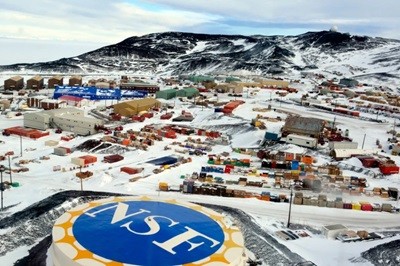The Arctic is warming faster on average than the rest of the world, with global consequences. Without curbing greenhouse-gas emissions, within 15 years, there could be no summer sea ice to reflect solar radiation from around Earth’s North Pole, amplifying heating elsewhere. Meltwater from ice sheets will push sea levels up. And the region’s thawing soils will release methane into the atmosphere, boosting greenhouse-gas concentrations further — such releases already seem to be accelerating1. All told, what’s happening now in polar regions could push the planet’s climate system beyond ‘tipping points’ into a completely new state. For example, ice cores show that ice sheets in Greenland and the Antarctic are extremely sensitive and could deteriorate suddenly, in unexpected ways2.
Such concerns have prompted the United Nations Intergovernmental Panel on Climate Change (IPCC) to urgently evaluate the risks of potential tipping points for warming, ice melting and sea-level rise in its forthcoming Seventh Assessment Report, which will be completed by 2029. Such investigations will require Arctic research on permafrost, land ecosystems, land ice, ice sheets and coasts to be conducted at full speed in the next two to three years.
Trump’s bid for Greenland threatens to destabilize Arctic research
Accomplishing this will be hard at a time when some world powers are hampering research in the region. Scientists need to speak up and develop joint programmes now to make this crucial work possible.
Arctic science has a long history of peaceful collaboration. Since the International Geophysical Year in 1957–58, joint Arctic research between nations has been conducted independently of geopolitics, just as it is on the International Space Station. For example, the International Biological Program (1964–74) enabled cross-country comparisons of tundra ecosystems across the far north, regardless of political borders and the cold war.
The end of the cold war brought more attention to science in the region, starting with the Murmansk Initiative on uniting economic, environmental and security issues in the Arctic, presented in 1987 by the Soviet Union’s then-leader, Mikhail Gorbachev. The International Arctic Science Committee was established in 1990 to promote collaboration between all Arctic nations.
Optimism rose further with the establishment of the Arctic Council in 1996, as a forum for coordination among foreign ministers of all Arctic states and representatives of Indigenous communities. This was badly needed then, as it is now, given the seriousness of the climate crisis.

Does US science have a future in Antarctica? Trump cuts threaten to cancel fieldwork and more
I am, in science terms, a child of this era, having started my PhD in 1990 on Arctic climate change, and having worked in the United Kingdom, Alaska, Sweden, Greenland, Denmark and Finland. I was part of the joint Swedish–Russian expedition to the Siberian tundra in 1994. It is tragic that political actions in the past few years have sabotaged this constructive environment for Arctic collaborations.